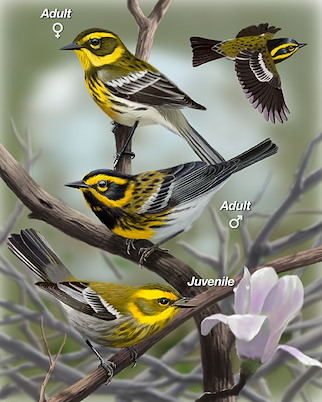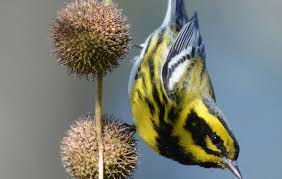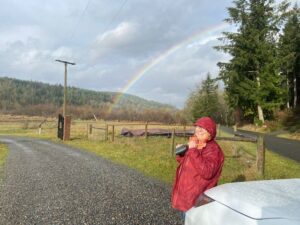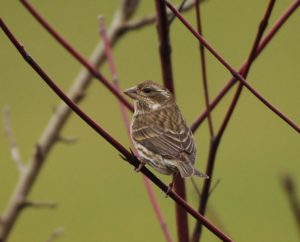
By Sharon Moore
Townsend’s Warbler – Satophaga townsendi
Family: Parulidae
Order: Passeriformes
The Townsend’s Warbler was “discovered” and named by American naturalist John Kirk Townsend in April of 1835, near the mouth of the Columbia River in what is now Oregon. How long these small birds have been spending the spring breeding season here in Western Washington we don’t know. What we do know is that this year, in 2020, they have arrived from their California, Mexico and Central America winter-feeding grounds somewhat early, ahead of many other songbird species. Our Pacific Northwest coastal coniferous forests and mountain ranges beckon the Townsend’s with tall, large-limbed trees in dense cover where the warblers have the highest chance of successfully raising their young.
These beautiful songbirds are a joy to observe in our woodlands. Larger than a Golden-crowned Kinglet and smaller than a Song Sparrow, they are diminutive at 4¾ inches long. The males sport an olive-green back and full yellow crescent around the black ear/eye patch. Yellow also appears in stripes down the male’s breast below the black cap and throat. Prominent, thick, white wing bars help us identify him. The lovely female presents even more color than the male, as her breast is pure yellow. Her black markings are paler on the head and at the throat though her dark ear/eye patch is still present. As with other warblers, the Townsend’s are slender-bodied with moderate length tails and small bills.
During the spring breeding season, the Townsend’s glean insects and their larvae from conifer needles and buds and even catch flying insects in midair. Though these birds are generally found in the tree canopy, when feeding their young they often come down into the understory for additional food sources. These may include caterpillars, ants, bees, moths, beetles, weevils and stinkbugs. They will also eat spiders, seeds and leaf galls. In winter and during migration they alter their diet, taking advantage of flower nectar along their flight route. At our backyard feeders, particularly in winter, we may entice them in with mealworms, peanut butter and suet.
Townsend’s Warblers are known to nest from sea level up through subalpine forests, as long as the trees are tall and dense. By late May the males will have chosen the best territories and begin to defend them with their buzzy songs varying in evenly pitched and high, thin notes. Those songs echoing softly through the forest provide melodious accompaniment for those of us who enjoy hiking while birding in the spring.

Once nest-building begins in earnest, the mated pair is known to search carefully for just the right branch in old-growth Douglas fir, spruce or hemlock on which to begin construction. Though not verified by actual observation, it’s likely that both sexes build the nest. Up to 60 feet above ground the pair chooses the top of a heavy branch, the end of which supports dense foliage, for the best-camouflaged, safest nest they can build. At four inches across and three inches deep, the shallow, cupped nest is composed of cedar bark, mosses, fir twigs and grass stems. Feathers, hair and more moss create a cozy home for the nestling. Observers have noted that some female Townsend’s Warblers may partially construct a nest in one tree, then, for an unknown reason, move all the materials to another tree and complete the nest there. By late June from 3 to 7 eggs are laid. Though incubation details are not well understood, it’s likely that both sexes warm the eggs for approximately 11 to 14 days. Once the hatchlings appear, the female, and possibly the male, feed the chicks for 9 to 11 days before they fledge.
One interesting note about the Townsend’s Warbler is that it may hybridize with the similar-looking Hermit Warbler. Their ranges overlap in narrow zones in Washington and Oregon. Over time, the more aggressive Townsend’s is displacing the Hermit Warbler. And what about the Townsend’s Warbler population stability? Until 2015 their numbers appeared stable. Now, however, it appears that their number is declining. This is most likely due to continuing loss of the forest habitat they need for successful breeding. Those causes are undoubtedly logging and habitat loss from global warming. The University of Washington Climate Change Impacts Assessment has recorded a temperature increase in the Pacific Northwest of 1.5 degrees Fahrenheit between 1920 and 2009. That climate-modeling project predicts a sharp increase to 2.0 degrees in the 2020s and on up to 3.2 degrees Fahrenheit by the 2040’s. Given that global warming is moving faster than originally predicted by scientists, the Townsend’s Warbler could lose, within the next twenty years, between 40% and 60% of the habitat it requires for reproducing. Unless we stop this steep warming curve, the heat will be catastrophic for this lovely songbird, and countless other northwest avian and animal species as they search for new habitat in order to survive.







